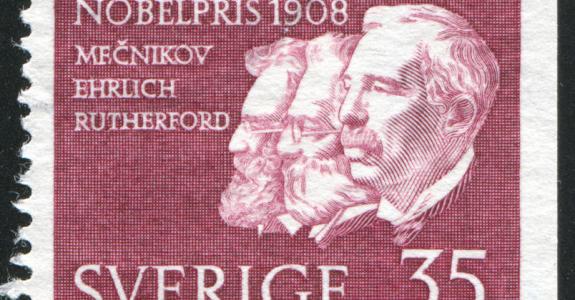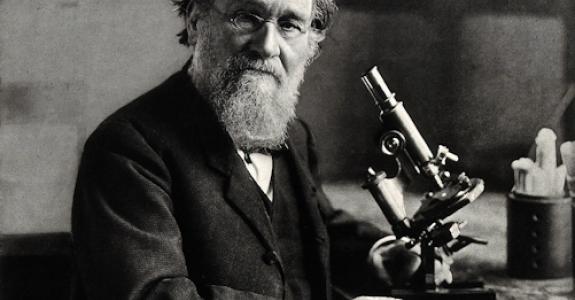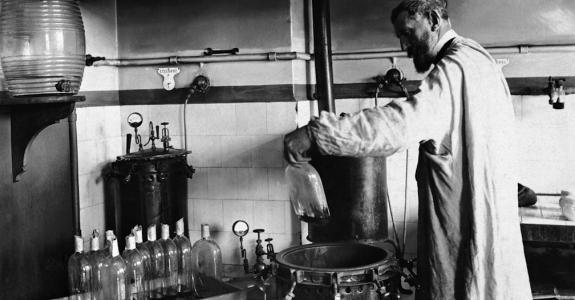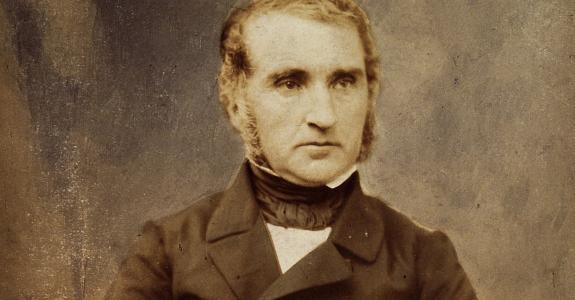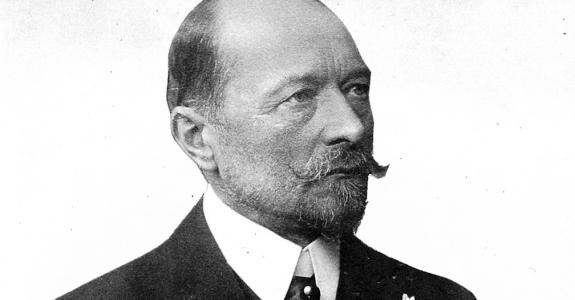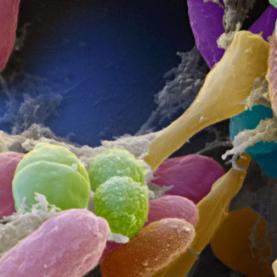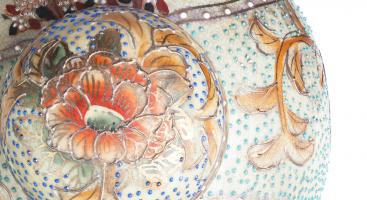Ilya Metchnikoff
Ilya Metchnikoff promoted yoghurt as beneficial to health and longevity. Why was that?
Ilya Metchnikoff discovered phagocytosis and was one of the first to investigate probiotics. ©CC
In 1908, Ilya Metchnikoff (1845-1916), a Russian zoologist, bacteriologist and immunologist, won the Nobel Prize for discovering the immune response of so-called scavenger cells (phagocytes). Around the same time, he also publicly promoted eating yoghurt as beneficial to health and longevity. Why was that? What prompted this renowned researcher to advocate a change in diet?
Autointoxication
At the time, Metchnikoff was Head of Research at the Pasteur Institute in Paris, where for years he had been intrigued by the notion of how and why humans age. This was a direct extension of his work on immunology, as he believed voracious scavenger cells to be the main culprits in premature ageing. His Études sur la nature humaine (1903) presented his view that ageing is a consequence of “disharmonies in the organisational structure of the human digestive system” (désharmonies dans l’organisation de l’appareil digestif de l’homme). Metchnikoff saw the colon as a harmful organ, a reservoir of undigested food that encourages colonies of putrefactive bacteria. In his opinion, this led to a self-poisoning of sorts (autointoxication) that would challenge the immune system. Since putrefactive bacteria in the intestines produce autotoxins, the older a person became, the greater the risk of scavenger cells in the intestines converting from fighting infection to destroying healthy tissue. Despite this pessimistic view, Metchnikoff considered his work an ‘optimistic philosophy’. He saw bacteriology, in conjunction with digestion and ageing, as a trend-setting science. He believed that, one day, medicine could prolong lives significantly – to up to 150 years, as it was only at this age that humans would reach a natural instinct to die. However, he thought that, at that time, there was no such thing as such a “natural death”; most people died at a younger age due to harmful influences. According to Metchnikoff, it was science’s role to find measures to prolong life for this hypothetical limit to become the norm.
Anti-ageing measures
Metchnikoff made various practical proposals for prolonging life, including ‘biological substitute therapies’ through gland transplants or hormone replacement (endocrine rejuvenation). Yet, it was lactic acid bacteria and their role in intestinal flora that fascinated him the most. Louis Pasteur first discovered these bacteria in the 1860s while studying the fermentation of wine. Bacteriologists were then quick to find additional types of lactic acid bacteria. In 1905, the Bulgarian researcher Stamen Grigorov discovered ‘Bacillus bulgaricus’, the lactic acid bacterium responsible for transforming milk into yoghurt. Metchnikoff heard about the young Bulgarian’s research and, two years later – in 1907 – he published his ideas on the health of Bulgaria’s rural populations. He declared that, in his opinion, the local farmers’ long life expectancy was due to their daily consumption of fresh yoghurt.
Fighting bacteria with bacteria
Metchnikoff also gave public presentations, reiterating his view that Bulgarian yoghurt in particular had the capacity to halt the ageing process caused by putrefactive bacteria in the intestines. He called on the public to employ thorough hygiene when handling fresh fruit and vegetables, but pointed out that the matter went beyond simply preventing harmful bacteria from entering the body. According to Metchnikoff, there were also ‘good’ bacteria that could be cultivated by consuming Bulgarian yoghurt and other forms of curdled milk. He alleged that, once in the intestines, these good bacteria would prevent putrefactive bacteria from forming on undigested food. Gripped by a general fear of bacteria, audiences eagerly accepted Metchnikoff’s reports on experiments where he and his team had observed microbes converting lactose into lactic acid, killing off putrefactive bacteria in the process. The Nobel Prize winner preached that the Bacillus bulgaricus found in Bulgarian curdled milk was ideally suited for this task. Since rural populations were consuming large quantities of curdled milk, he added that there was reason to assume that the striking longevity of many Bulgarians could be credited to their intake of yoghurt.
The yoghurt boom
The general public took heed of Metchnikoff’s message that there was a connection between self-poisoning, ageing, and yoghurt as a life-prolonging foodstuff. This led to a rush on yoghurt and other curdled-milk products. While people in Western Europe were familiar with buttermilk or milk that had soured spontaneously, in terms of bacteriology, this was the result of an impure fermentation process (with by-products such as butyric acid, carbonic acid and alcohol). Metchnikoff’s proposal of first boiling the milk to kill off this additional flora and then adding pure cultures of desirable bacterial strains was a completely new approach. The years that followed saw an abundance of specialist medical literature recommend the consumption of yoghurt as a remedy, dietary aid, curative treatment and foodstuff.
Bulgarian yoghurt became an elixir, and Bacillus bulgaricus the longevity microbe. It was said to cure all possible diseases, including mental illnesses such as depression, melancholia and hypochondria. Pharmacies and chemists across Europe, and subsequently in the United States, started selling ready-made yoghurt, as well as starter cultures in powder and tablet form to be taken just as they were or used to make yoghurt at home. Metchnikoff distanced himself from this profiteering, but it was too late. Nothing could dampen the enthusiasm surrounding the notion of beneficial bacteria fighting harmful bacteria in the body, particularly in the intestines. Yoghurt totally changed dietetics in the 1910s. Undigested proteins from predominantly meat-based diets were considered particularly problematic. The aim of the new diet was to prevent non-absorbed proteins from being broken down in the colon and thus producing toxic metabolic products which, once absorbed in the bloodstream, would lead to a self-poisoning of sorts (autointoxication). The craze for Bulgarian yoghurt finally died down in the 1920s – and even then only because of the discovery of another lactic acid bacterium, Lactobacillus acidophilus, which marked the start of a new wave of promoting bacteriotherapy, the precursor to modern probiotics.
Scientists who changed our diet
Throughout history, many scientists rose to fame for their inventions, discoveries and advice for an improved diet. Here are a few more examples from the 19th century:




